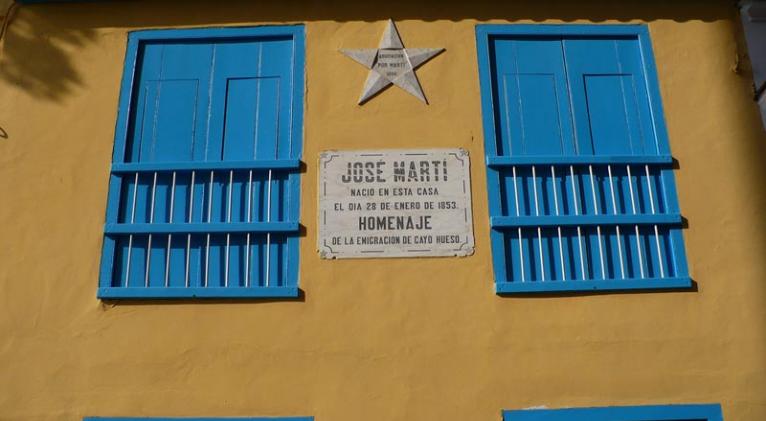La Casita de Martí, Venerated Site of Cuba
especiales

The birthplace of the National Hero of Cuba, José Martí, is one of the residences of the hero that still exist, hence its relevance for the approach of the new generations to this exceptional figure.
This is how Ramón Guerra, museologist of that facility located in Old Havana, assessed it, who in a dialogue with Prensa Latina affirmed that the Apostle of independence always lived placing Cuba and its freedom from the Spanish metropolis as the first and most important thing, regardless of personal circumstances.
"Martí was actually a poor man, but in terms of talent he had unparalleled wealth, the result of his parents' desire to make of him a person with studies," Guerra said.
FIRST STEPS
Don Mariano Martí and Doña Leonor Pérez were married in 1852, and the following year José Julián Martí Pérez was born; it was a very humble family that lived in the two upper rooms of what’s now known as the Birthplace Museum, the specialist said.
“The house was also shared by the Doña Leonor's sister and Don Mariano's cousin, together with the children of the marriage. These circumstances created a very suitable environment for the development of Martí, together with his cousins and later his sisters”, she commented.
As the family grew in numbers and depending on the father's work as a neighborhood watchman, they had to move to several places in Havana, mainly in the current municipalities of Habana Vieja and Centro Habana; Of these houses, the only one that still stands is the one that serves as a museum on Paula street.
“Martí learned to read and write in neighborhood schools, then he attended his sixth grade at a school on Reina street. The only photo that exists of the hero when he was a child was taken at this school,” said Guerra.
After finishing his sixth grade, his mother managed to get him to enter Rafael María de Mendive's school, who saw so much potential and talent in Martí that he paid for his secondary education, despite his father's wishes that the young man supported him in the family economy.
POLITICAL GROWTH
The break of war in 1868, set the capital in turmoil. By then, Martí supported the laborers, a name given to the conspirators against the Spanish colonial regime, with whom he was in contact because they belonged to the environment in which Mendive, the mentor, worked.
“From him he learned that Cuba is the Homeland and not the colony of Spain, an idea that would drive him throughout his life. When he was barely 15 years old, Martí circulated the poem October 10 among his classmates at the secondary school,” said the museologist.
His strong ideas for independence led him to be sentenced to six years in prison and forced labor in San Lázaro quarries. Due to the efforts of his parents, he only served one, he was transferred to Isle of Pines and later exiled to Spain, where he managed to finish his studies.
Guerra said that during his time there he didn’t disassociate himself from politics, and while the coup against the king and the subsequent emergence of the first Spanish republic took place, he wrote the manuscript La república española frente a la revolución cubana.
“Martí was not yet a leader, but since he already showed all his talent, he still didn’t write for big newspapers. His health was not the best either, between the climate of Spain and the injuries from prison, there are days when he could not even get out of bed, in addition, his situation as a political exile without access to many resources also slowed him down”, said the historian.
“Then came Martí's time in Latin America, here he developed his journalism. He visited countries like Venezuela and Guatemala, where he left his mark as a writer, but not being for sale and opposing the wishes of the rulers, he had to leave" she recounted.
HISTORY OF THE HOUSE AFTER MARTÍ’S DEMISE
The determination of the National Hero to see the Caribbean nation free led him to found the Cuban Revolutionary Party, organize the so-called Necessary War and die in combat in the fields of Cuba on May 19th, 1895.
After that event and with the U.S. military intervention (1899-1901), the Cuban émigrés decided to come to the island to place a plaque in the house where Martí was born, for which they raised money.
"On January 28, 1899, they placed the tarja on the façade and Mrs. Leonor Pérez was with them," Guerra said.
«A year later the emigrants gathered money again, this time to buy the house and decided to give the keys to Doña Leonor so that she could live in it. According to the agreement, when she died, the house would go to a group that intended to use it as a space to pay homage to Martí, preferably a museum, "she explained.
However, the mother found herself in need of renting the house to earn a living, until her death in 1921, the date for which the association in charge of managing the property was dissolved and, therefore, the new tenants continued to inhabit it without paying .
The family knew the history that accompanied the house, but it was never their desire to profit from it, according to the statements they offered in an interview in 1921. "No, we didn't take the house, they stopped charging for it and well, we just we lived here”, they said then.
"The property underwent transformations over the years, due to the advanced state of deterioration, such as the façade or the subdivisions built inside, since Leonor's death there are no photographs of the place," said the specialist.
These elements made the recovery of the historical value of the property more complex, which occurred in 1921, when the journalist and Freemason Arturo R. de Carricarte obtained ownership of the house, after three years of work.
Thanks to his influence, he was able to find the papers of the Association's agreement, which dictated: “To allocate the house as a place to pay homage to José Martí”.
"Although the government on duty supported Carricarte's decision, it did so only symbolically, so the budget for the recovery of the original appearance of the property came out of the journalist's own pocket and from various fundraisers that were carried out. out," Guerra expanded.
The works began in 1921, when it was possible, thanks to existing photographs, to restore the façade. The interior remained with the modified structure, but in a general sense the house was preserved quite similar to its original state. The museum was inaugurated in 1925.
MARTÍ'S HOUSE AS A MUSEUM
«The museum opened with a modest collection. On the ground floor there was a collection dedicated mainly to the Cuban struggle movement and the few objects they had from Martí were exhibited in the two upstairs rooms,” the museologist specified.
Carricarte remained as director of the institution until his retirement in 1948, the same year that he died. Later it began to be directed by the National Archive, which was in charge of the budget.
The boom and support continued, and there is even a legend that the student and communist leader Julio Antonio Mella, and the students of his time, were very close to the process and collaborated in the assembly and reconstruction of the house.
"In 1953, on the occasion of the centenary of the birth of José Martí and during the government of Fulgencio Batista (1952-1958), the house was rebuilt again due to its poor condition," Guerra commented.
Later, after the triumph of the Revolution, a capital restoration of the building was necessary, since the explosion of the steamer La Coubre (March 4, 1960) damaged the structure of the house and created cracks.
"Currently, the Casa Natal has the largest collection of objects about Martí, donated by family and friends of the National Hero," said the specialist.
Translated by Amilkal Labañino / CubaSí Translation Staff














Add new comment